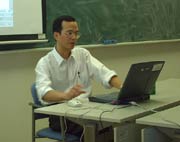The 3rd WORKSHOP 20 September 2003 (Sat), GRIPS, Tokyo 14:00-16:00 |
|||
| Subject:
Exports and Long-run Growth in Vietnam, 1976-2001
by Mr. Phan Minh Ngoc |
|||
|
The third workshop of JVEC was held on September 20, 2003 at GRIPS. Mr. Phan Minh Ngoc, a Ph.D. candidate at Kyushu University, made a presentation on his paper "Exports and Long-run Growth in Vietnam, 1976-2001." His presentation included five parts: the background, a brief literature review on exports and growth, methods and data, empirical results, and some explanations. After reviewing the background and the literature concerning the relation between export and growth, the author concentrated on explaining his methods and empirical results. His hypothesis is that export has limited impacts on economic growth in the long run in Vietnam. To prove this, he used a simple growth model to evaluate the effects of export to economic growth. He also examined correlations between export-related variables and GDP-related variables and used an ECM (error-correction model) to deal with the problem of cointegration in the variables. The empirical results show that there is no firm evidence for the relation between export and growth. They are either statistically insignificant or small in the absolute values. In addition, the results of Granger-causality tests for export and growth also indicate no causality relation between them. Based on these results, he argued that export does not play a leading role in Vietnam's economic growth as usually expected. Then, he explained the reasons. Possible explanations included poor quality of the data, export structure, weak backward linkages, weak linkage between export promotion and industrialization, excessive trading partner concentration, and inefficient allocation of resources to the export sector. Finally, he concluded that although the export sector has expanded robustly in recent years, econometrics does not support the view that export is an engine of economic growth in Vietnam, unlike other East Asian economies such as NICs. There were many exciting opinions and discussions during the workshop. First, regarding the methods of analyses, it might be more precise to consider both the demand and supply side because export is a component of GDP in the demand side. Some favored techniques based on microanalyses or using different production specifications. Second, there existed some problems in the data, such as the quality of estimated GDP before 1986, the ambiguously low share of the industrial sector in GDP, and the data processing techniques. Third, the author's interpretations were questioned in the issues of export structure, excessive trading partner concentration, export competitiveness, or policies concerning the agricultural sector. Furthermore, there was also a comment that the idea that export growth does not affect economic growth at the macro level in the long run is obvious; export only affect economic growth under the context of considering micro frameworks, such as technological transfers, shifting the labor and economic structure, and enhancing the competitiveness of the economy in the long run. The author emphasized that he only focused on the issues defined by the paper; however, he also agreed that these opinions and comments would be very useful for his further studies in the future.
|
|||
